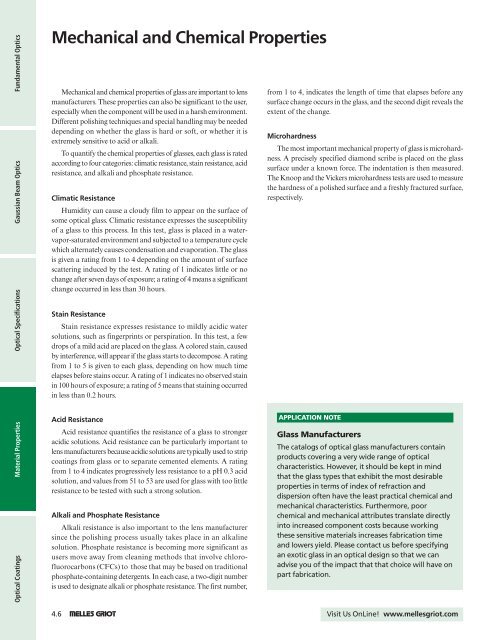Optical Coatings
Optical Coatings
Optical Coatings
Create successful ePaper yourself
Turn your PDF publications into a flip-book with our unique Google optimized e-Paper software.
Fundamental Optics<br />
Material Properties <strong>Optical</strong> Specifications Gaussian Beam Optics<br />
<strong>Optical</strong> <strong>Coatings</strong><br />
Mechanical and Chemical Properties<br />
Mechanical and chemical properties of glass are important to lens<br />
manufacturers. These properties can also be significant to the user,<br />
especially when the component will be used in a harsh environment.<br />
Different polishing techniques and special handling may be needed<br />
depending on whether the glass is hard or soft, or whether it is<br />
extremely sensitive to acid or alkali.<br />
To quantify the chemical properties of glasses, each glass is rated<br />
according to four categories: climatic resistance, stain resistance, acid<br />
resistance, and alkali and phosphate resistance.<br />
Climatic Resistance<br />
Humidity can cause a cloudy film to appear on the surface of<br />
some optical glass. Climatic resistance expresses the susceptibility<br />
of a glass to this process. In this test, glass is placed in a watervapor-saturated<br />
environment and subjected to a temperature cycle<br />
which alternately causes condensation and evaporation. The glass<br />
is given a rating from 1 to 4 depending on the amount of surface<br />
scattering induced by the test. A rating of 1 indicates little or no<br />
change after seven days of exposure; a rating of 4 means a significant<br />
change occurred in less than 30 hours.<br />
Stain Resistance<br />
Stain resistance expresses resistance to mildly acidic water<br />
solutions, such as fingerprints or perspiration. In this test, a few<br />
drops of a mild acid are placed on the glass. A colored stain, caused<br />
by interference, will appear if the glass starts to decompose. A rating<br />
from 1 to 5 is given to each glass, depending on how much time<br />
elapses before stains occur. A rating of 1 indicates no observed stain<br />
in 100 hours of exposure; a rating of 5 means that staining occurred<br />
in less than 0.2 hours.<br />
Acid Resistance<br />
Acid resistance quantifies the resistance of a glass to stronger<br />
acidic solutions. Acid resistance can be particularly important to<br />
lens manufacturers because acidic solutions are typically used to strip<br />
coatings from glass or to separate cemented elements. A rating<br />
from 1 to 4 indicates progressively less resistance to a pH 0.3 acid<br />
solution, and values from 51 to 53 are used for glass with too little<br />
resistance to be tested with such a strong solution.<br />
Alkali and Phosphate Resistance<br />
Alkali resistance is also important to the lens manufacturer<br />
since the polishing process usually takes place in an alkaline<br />
solution. Phosphate resistance is becoming more significant as<br />
users move away from cleaning methods that involve chlorofluorocarbons<br />
(CFCs) to those that may be based on traditional<br />
phosphate-containing detergents. In each case, a two-digit number<br />
is used to designate alkali or phosphate resistance. The first number,<br />
from 1 to 4, indicates the length of time that elapses before any<br />
surface change occurs in the glass, and the second digit reveals the<br />
extent of the change.<br />
Microhardness<br />
The most important mechanical property of glass is microhardness.<br />
A precisely specified diamond scribe is placed on the glass<br />
surface under a known force. The indentation is then measured.<br />
The Knoop and the Vickers microhardness tests are used to measure<br />
the hardness of a polished surface and a freshly fractured surface,<br />
respectively.<br />
APPLICATION NOTE<br />
Glass Manufacturers<br />
The catalogs of optical glass manufacturers contain<br />
products covering a very wide range of optical<br />
characteristics. However, it should be kept in mind<br />
that the glass types that exhibit the most desirable<br />
properties in terms of index of refraction and<br />
dispersion often have the least practical chemical and<br />
mechanical characteristics. Furthermore, poor<br />
chemical and mechanical attributes translate directly<br />
into increased component costs because working<br />
these sensitive materials increases fabrication time<br />
and lowers yield. Please contact us before specifying<br />
an exotic glass in an optical design so that we can<br />
advise you of the impact that that choice will have on<br />
part fabrication.<br />
4.6 1 Visit Us OnLine! www.mellesgriot.com
















